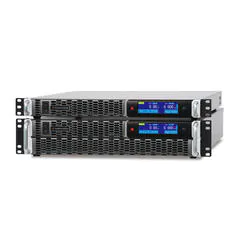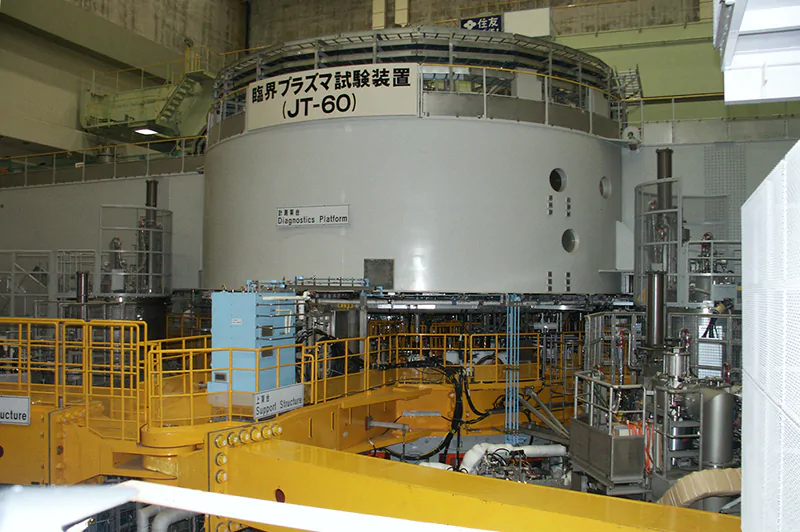
The safety of nuclear power generation has been discussed again, and fusion power generation, which is safe even with the same "nuclear power", is drawing attention. In particular, the tokamak fusion reactor, which traps plasma in a magnetic field, has taken great steps toward practical use. This reactor was adopted as the International Thermonuclear Experimental Reactor (ITER). On the other hand, many people have the image of being "scary" because it is labeled as "nuclear". This time, we will explain what fusion power generation is and how it differs from conventional nuclear power generation.
What is Fusion Power Generation? -The Advantages and Disadvantages
Fusion power generation is a technology that "generates power by fusing atomic nuclei." This is related to the following famous formula that Einstein put out when he published the theory of relativity.
E=mc2
In this equation, E is energy, m is mass, and c is the speed of light.
We will explain in a little more detail. Atomic nuclei are found in all atoms, and their weight varies depending on the type of element. For example, hydrogen usually weighs 1 (called atomic weight), 12 for carbon, and 16 for oxygen. However, depending on the difference in the number of neutrons in the nucleus, even hydrogen may have an atomic weight of 2 or 3.
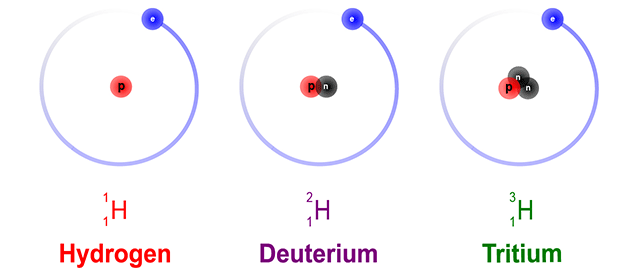
On the other hand, some heavy nuclei, such as uranium-235 and uranium-238, weigh more than 200 times as much as hydrogen. Plutonium is also 239, which is a famous element related to "nuclear technology". Some artificially created elements are heavier, for example, the atomic weight of nihonium successfully synthesized by RIKEN is 286.
Now, a light element changes into a heavier element by sticking multiple elements together. This is called "nuclear fusion."
Fusion power uses a "nuclear fusion reaction" in which deuterium and tritium undergo nuclear fusion and change to helium. The nuclear fusion reaction in which hydrogen becomes helium is also the reaction that is actually occurring in the sun.
In this process, the weight after the reaction is lighter than the original weight before the reaction. That amount is converted into the energy calculated by the above formula, and the sun continues to shine with this energy. And "fusion power generation" is to use this energy to generate electricity.
Specifically, the energy generated by the nuclear fusion reaction boils water to create high-temperature steam. When this steam is applied to the turbine to rotate it, the generator connected to the turbine generates electricity. By the way, "thermal power generation" produces this steam from the heat generated by burning natural gas, heavy fuel oil (petroleum), coal, etc.
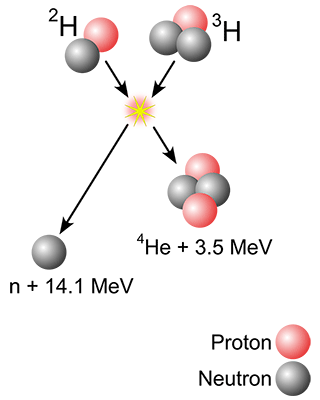
A key advantage of fusion power generation is that it is "carbon-free", which does not generate CO2 like thermal power generation. Of course, the following two points are also big advantages.
- Japan has inexhaustible resources because deuterium as fuel can be extracted from seawater.
- Unlike nuclear power generation, there is no concern about a nuclear explosion.
Fusion is difficult to sustain, so if the fusion reactor is damaged, the reaction will automatically stop. Therefore, there is no concern that deuterium, which is a fuel, will leak out. More on that later.
On the other hand, the disadvantage is that the neutrons used in the reaction process activate the fusion reactor walls and buildings, resulting in small amounts of Low-level radioactive waste.
What is Nuclear Power Plant?
So, what is nuclear power generation that also uses atomic nuclei? Unlike the nuclear fusion introduced above, nuclear power generation uses the energy generated by "fission."
For example, the nucleus of uranium-235 becomes unstable when exposed to neutrons and splits into multiple lighter elements.
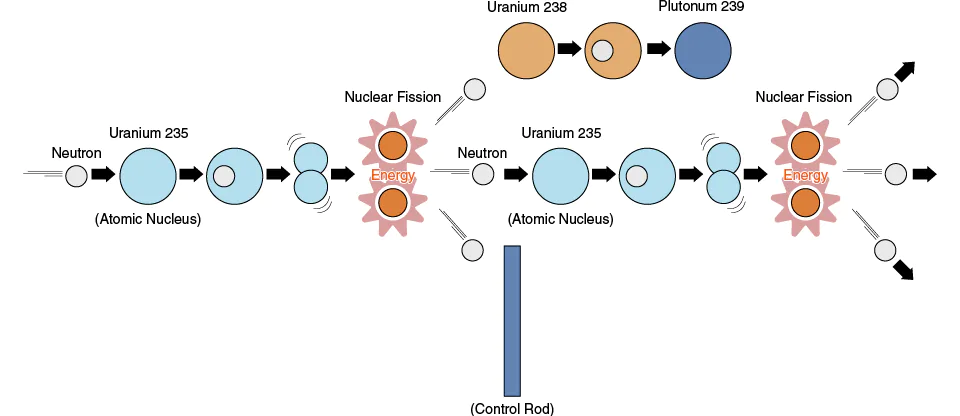
In this time, the mass of all the elements after division is lighter than that of the original uranium-235, so the difference comes out as energy. It is the same as thermal power generation that the energy that comes out generates steam to turn the turbine.
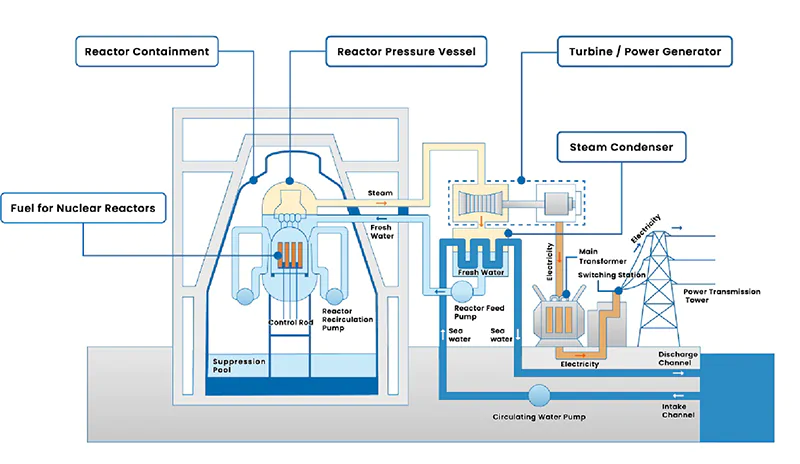
The problem is that uranium-235 has radioactivity. If the reaction rate cannot be controlled well, the reactor may explode, and uranium-235 and plutonium-239 will be scattered around. This was the accident that occurred at the Chernobyl nuclear power plant and the Fukushima Daiichi nuclear power plant.
In addition, even if an explosion does not occur, the elements after division may also have radioactivity, so how to dispose of the remaining nuclear waste is also a problem.
Research and Development of Fusion Power
So how far has fusion power been developed? As a matter of fact, at present, there is still no commercial power plant.
Since nuclear fusion is also a phenomenon occurring in the sun, it is necessary to cause a reaction by hitting deuterium, which is a fuel, in an ultra-high temperature state. Moreover, to keep deuterium in an ultra-high temperature state, the inside of the fusion reactor must be evacuated. This is because the presence of other gases can get in the way. And it is necessary to confine it with a strong magnetic field so that it does not diffuse from the reactor.
Another method is "laser fusion," in which deuterium is contained and nuclear fusion is performed by shining a high-power laser from around 360 degrees.
However, enormous energy is required to achieve all the conditions. We are trying to perform nuclear fusion to extract energy, but it takes a huge amount of energy to perform nuclear fusion.
In the research, no matter how much energy you put in, it doesn't matter if you can confirm the fusion reaction. However, when it comes to power generation, it is meaningless unless we can extract more energy than we put in. For example, the unit can be kW, MW, or GW, so if you put in 1 (ex. GW), you need to be able to take out 1.1 (GW). It cannot be used for commercial power generation if 1 (GW) is input and only 0.9 (GW) can be taken out.
So how far have we been now? In 1968, humankind first succeeded in artificially generating a fusion reaction in a magnetic field-based fusion reactor developed by the former Soviet Union. Naturally, at this time, the amount of energy input was many orders of magnitude higher than the amount of energy that could be extracted.
In 1998, it was the fusion experimental reactor JT-60 owned by the Japan Atomic Energy Research Institute that produced the experimental results that seemed to exceed the energy extracted for the first time in the world. Still, it was not enough to generate electricity.
At present, research on fusion power generation is progressing so that the value of Q will be about 5 to 10. Q can be calculated by the following formula.
Q = Output energy ÷ Input energy

Structure of Fusion Reactor
Well what kind of structure does a fusion reactor have? There are two types, "magnetic confinement fusion reactor (MCFR)" and "inertial confinement fusion reactor". Among the MCFR, the "tokamak fusion reactor (TFR)", which has the longest research history, is the most advanced and adopted by ITER. JT-60 is also this type. The "laser fusion" introduced earlier is an "inertial confinement fusion reactor" type.
In the TFR, the inside of the fusion reactor is evacuated, and the fuel heated to 100 million degrees or more (the target temperature is 120 million degrees or more) and turned into plasma is put into it. Plasma is made by stripping all electrons from an atom and leaving only the nucleus.
Then, it is confined in a narrow area with a strong magnetic field so that the temperature of the fuel plasma can be kept at an ultra-high temperature. Otherwise, the plasma will hit the walls of the fusion reactor, lose energy and cool.
This magnetic field is generated by the current flowing in the toroidal direction. This current is called plasma current. And the larger the plasma current, the higher the plasma performance. However, the strength of the magnetic field generated by this plasma current is 4.0T (Tesla) for JT-60 and 5.2T for ITER. The value of plasma current reaches 15 million A.
A superconducting material is indispensable for the stable flow of such a large current. If there is resistance, heat will be generated by that amount, so extra power will be required. Nb3Sn superconducting wire is used in ITER, but it is not a high-temperature superconductor. Therefore, some power is required for cooling this wire.
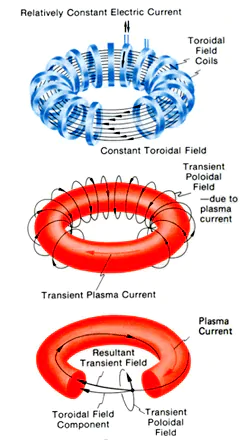
The state of the plasma confined in this way is measured by a method called the probe method. It is commonly called a Langmuir probe.
In this method, microelectrodes are inserted into the plasma, and various quantities are measured from the current-voltage characteristics obtained by applying a voltage to the reference electrode. Experiments are continuing to find out what the values of the parameters that lead to stable fusion are.
Development Status of Fusion Power Generation
Finally, we introduce about the current state of fusion power generation. It is believed that the international thermonuclear experimental reactor "ITER" can establish the basic technology required for fusion power generation worldwide. ITER was attracted by each country including Japan, and it is finally being constructed in Cadarache, France. The operation is scheduled to start in 2025, and various experiments will start from there. Researchers are trying to carry out stable fusion operation in 2035.
In response to this situation, there are moves to develop fusion reactors even in the private sector. For example, in 2014, Lockheed Martin of the United States announced that "Developing a 100 MW class commercial small fusion reactor that can be loaded into a truck within 10 years."
However, it seems that the progress after that is not good. Still, Google, Amazon founder Jeff Bezos, and Microsoft founder Bill Gates are driving development.
On the other hand, in Japan, risk-free investment is the mainstream, so it is not progressing at all like space development.
In addition, because it is often spoken of with the bad image of "next-generation nuclear power plant," it is often shunned by the bad image of the word rather than the cleanliness of power generation itself and the inexhaustible resources. However, fusion energy is a resource that can support future energy policy with renewable energy and two pillars. In addition, Japan has the world's top-level technology, so we hope that it will spread.
Recommended products
Matsusada Precision offers four-quadrant bipolar power supplies for plasma measurements.
Reference (Japanese site)
- Japanese source page 「核融合発電と原子力発電の違い」
(https://www.matsusada.co.jp/column/nuclear_fusion_power_generation.html) - ニホニウム(理化学研究所)
(https://www.riken.jp/pr/fun/nh/) - 原子力発電の概要(関西電力)
(https://www.kepco.co.jp/energy_supply/energy/nuclear_power/shikumi/kakubunretsu.html) - 原子燃料サイクルとプルトニウム利用(プルサーマル)(中国電力)
(https://www.energia.co.jp/atom/more5.html) - 原子力発電のしくみ(東京電力)
(https://www.tepco.co.jp/electricity/mechanism_and_facilities/power_generation/nuclear_power/nuclear_power_generation.html) - 原子力百科事典 ATOMICA
(https://atomica.jaea.go.jp/) - 核融合研究(文部科学省)
(https://www.mext.go.jp/a_menu/shinkou/iter/019.htm) - 欧州の共同核融合研究機関、記録的な核融合エネルギー放出に成功(JETRO)
(https://www.jetro.go.jp/biznews/2022/02/ca1403cdba757920.html) - 核融合研究開発の現状(文部科学省)
http://www.aec.go.jp/jicst/NC/iinkai/teirei/siryo2021/siryo13/2_haifu.pdf - 工学実証段階にきた核融合発電研究の現状と課題
(https://www.chuden.co.jp/resource/seicho_kaihatsu/kaihatsu/kai_library/news/news_158_02.pdf) - よくわかる核融合炉のしくみ(日本原子力学会誌)
https://www.aesj.or.jp/~fusion/aesjfnt/jp/publications/rensai1/rensai_all.pdf - プローブ計測の基礎から応用まで(プラズマ・核融合学会)
(https://www.jspf.or.jp/Journal/PDF_JSPF/jspf2005_07/jspf2005_07-482.pdf) - 次世代技術「核融合」、欧米と日本でこんなに違う扱い(日本経済新聞)
https://www.nikkei.com/article/DGXZQOFK054HD0V00C21A3000000/






